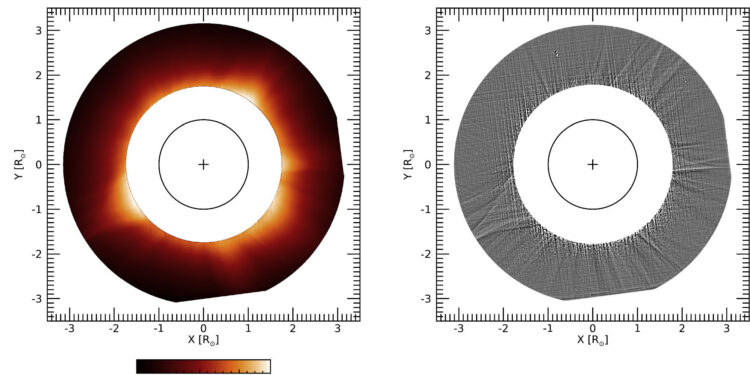(a) Average of the 298 coronal brightness images acquired by Metis between 10:15 and 20:16 UT on October 12, 2022. (b) Same as (a), but with the DoG filter applied to refine the boundaries between the different coronal magnetic fields. structures. Credit: Letters from the astrophysical journal (2024). DOI: 10.3847/2041-8213/ad5a8c
The solar wind is a constant stream of charged particles coming from the sun. Rather than a constant breeze, this wind is more gusty. As solar wind particles travel through space, they interact with the sun’s varying magnetic field, creating a chaotic, fluctuating motion called turbulence.
A video confirms something long suspected: the turbulent motion of the solar wind begins very close to the sun, inside the solar atmosphere known as the corona. Small disturbances affecting the solar wind in the corona are transported outward and expand, generating turbulent flow further into space.
By blocking direct light from the sun, Solar Orbiter’s Metis coronagraph instrument is able to capture the weaker visible and ultraviolet light coming from the solar corona. Its high-resolution images show the detailed structure and movement within the corona, revealing how turbulent solar wind motion already becomes at its roots.
The red-tinted ring in the video shows the Metis observations made on October 12, 2022. At the time, the spacecraft was just 43.4 million km from the sun, less than a third of the Sun- Earth. The video of the sun at the center of the video was recorded by Solar Orbiter’s Extreme Ultraviolet Imager (EUI) on the same day.
“This new analysis provides the first-ever evidence of fully developed turbulence in the solar corona. Solar Orbiter’s Metis coronagraph was able to detect it very close to the sun, closer than any spacecraft could get. approach the sun and make local measurements,” explains Daniel Müller, ESA’s Solar Orbiter project scientist.
Turbulence affects how the solar wind is heated, how it moves through the solar system, and how it interacts with the magnetic fields of the planets and moons it passes through. Understanding solar wind turbulence is crucial for predicting space weather and its effects on Earth.
A study on this subject is published in Letters from the astrophysical journal.
More information:
Daniele Telloni et al, Métis observation of the appearance of fully developed turbulence in the solar corona, Letters from the astrophysical journal (2024). DOI: 10.3847/2041-8213/ad5a8c
Provided by the European Space Agency
Quote: The turbulent solar wind originates in the solar corona, according to a study (September 26, 2024) retrieved September 27, 2024 from
This document is subject to copyright. Except for fair use for private study or research purposes, no part may be reproduced without written permission. The content is provided for informational purposes only.



